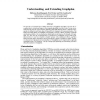Free Online Productivity Tools
i2Speak
i2Symbol
i2OCR
iTex2Img
iWeb2Print
iWeb2Shot
i2Type
iPdf2Split
iPdf2Merge
i2Bopomofo
i2Arabic
i2Style
i2Image
i2PDF
iLatex2Rtf
Sci2ools
ECP
1997
Springer
1997
Springer
Understanding and Extending Graphplan
We provide a reconstruction of Blum and Furst’s Graphplan algorithm, and use the reconstruction to extend and improve the original algorithm in several ways. In our reconstruction, the process of growing the planning-graph and inferring mutex relations corresponds to doing forward state-space refinement over disjunctively represented plans. The backward search phase of Graphplan corresponds to solving a binary dynamic constraint satisfaction problem. Our reconstruction sheds light on the sources of strength of Graphplan. We also use the reconstruction to explain how Graphplan can be made goaldirected, how it can be extended to handle actions with conditional effects, and how backward state-space refinement can be generalized to apply to disjunctive plans. Finally, we discuss how the backward search phase of Graphplan can be improved by applying techniques from CSP literature, and by teasing apart planning and scheduling (resource allocation) phases in Graphplan.
Backward Search Phase | ECP 1997 | ECP 1999 | Furst’s Graphplan Algorithm | State-space Refinement |
| Added | 07 Aug 2010 |
| Updated | 07 Aug 2010 |
| Type | Conference |
| Year | 1997 |
| Where | ECP |
| Authors | Subbarao Kambhampati, Eric Parker, Eric Lambrecht |
Comments (0)

